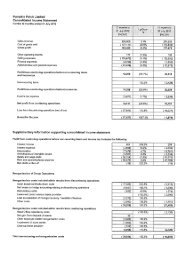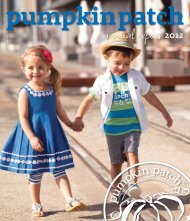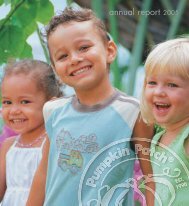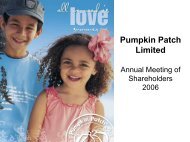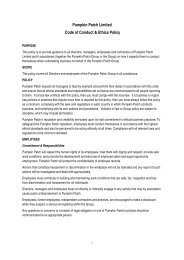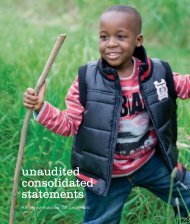annual report - Pumpkin Patch investor relations
annual report - Pumpkin Patch investor relations
annual report - Pumpkin Patch investor relations
Create successful ePaper yourself
Turn your PDF publications into a flip-book with our unique Google optimized e-Paper software.
PUMPKIN PATCH LIMITED & SUBSIDIARIES NOTES TO THE FINANCIAL STATEMENTS 31 JULY 2010<br />
PUMPKIN PATCH LIMITED & SUBSIDIARIES NOTES TO THE FINANCIAL STATEMENTS 31 JULY 2010<br />
2 SUMMARY OF SIGNIFICANT ACCOUNTING POLICIES continued<br />
- Shop fit out ........................................................................................5-10 years<br />
- Office equipment (including furniture and fittings (F&F)) .................................5-10 years<br />
- Computer equipment (including point of sale equipment (POS)) ......................3-5 years<br />
- Plant and machinery ............................................................................3-7 years<br />
- Vehicles ............................................................................................4-5 years<br />
- Leasehold improvements .......................................................................6-7 years<br />
The assetsÕ residual values and useful lives are reviewed, and adjusted if appropriate,<br />
at each balance sheet date.<br />
An assetÕs carrying amount is written down immediately to its recoverable amount<br />
if the assetÕs carrying amount is greater than its estimated recoverable amount.<br />
Gains and losses on disposals are determined by comparing proceeds with carrying<br />
amount. These are included in the Income Statement.<br />
(R) INTANGIBLE ASSETS<br />
(i) Trademarks<br />
Trademarks have a finite useful life and are carried at cost less accumulated amortisation<br />
and impairment losses. Amortisation is calculated using the straight line method to allocate<br />
the cost of trademarks and licences over their estimated useful lives, which varies from three<br />
to five years.<br />
(ii) Software costs<br />
Acquired computer software licences are capitalised on the basis of the costs incurred<br />
to acquire and bring to use the specific software. These costs are amortised over their<br />
estimated useful lives (three to five years).<br />
Costs associated with developing or maintaining computer software programmes are<br />
recognised as an expense as incurred. Costs that are directly associated with the production<br />
of identifiable and unique software products controlled by the Group, and that will probably<br />
generate economic benefits exceeding costs beyond one year, are recognised as intangible<br />
assets. Direct costs include the software development employee costs.<br />
Computer software development costs recognised as assets are amortised over their<br />
estimated useful lives (not exceeding five years).<br />
(S) TRADE AND OTHER PAYABLES<br />
Trade and other payables are initially recognised at fair value and subsequently<br />
at amortised costs.<br />
These amounts represent liabilities for goods and services provided to the Group prior<br />
to the end of financial year which are unpaid. The amounts are unsecured and are<br />
usually paid within 30 days of recognition.<br />
(T) BORROWINGS<br />
Borrowings are initially recognised at fair value, net of transaction costs incurred.<br />
Borrowings are subsequently measured at amortised cost. Any difference between<br />
the proceeds (net of transaction costs) and the redemption amount is recognised in the<br />
Income Statement over the period of the borrowings using the effective interest method.<br />
Borrowings are classified as current liabilities unless the Group has an unconditional right<br />
to defer settlement of the liability for at least 12 months after the balance sheet date.<br />
The classification of borrowings reflects the underlying bank facility agreement.<br />
(U) PROVISIONS<br />
Provisions are recognised when the Group has a present legal or constructive obligation as<br />
a result of past events, it is more likely than not that an outflow of resources will be required<br />
to settle the obligation, and the amount has been reliably estimated. Provisions are not<br />
recognised for future operating losses.<br />
(V) EMPLOYEE BENEFITS<br />
(i) Wages and salaries, <strong>annual</strong> leave and sick leave<br />
Liabilities for wages and salaries, including non-monetary benefits, <strong>annual</strong> leave and<br />
accumulating sick leave expected to be settled within 12 months of the <strong>report</strong>ing date<br />
are recognised in the provision for employee benefits in respect of employeesÕ services<br />
up to the <strong>report</strong>ing date and are measured at the amounts expected to be paid when the<br />
liabilities are settled. Liabilities for non-accumulating sick leave are recognised when the<br />
leave is taken and measured at the rates paid or payable.<br />
(ii) Long service leave<br />
The liability for long service leave is recognised in the provision for employee benefits<br />
and measured as the present value of expected future payments to be made in respect<br />
of services provided by employees up to the <strong>report</strong>ing date. Consideration is given to<br />
experience of employee departures and periods of service.<br />
(iii) Employee share based payments<br />
The Group operates an equity-settled, share-based compensation plan. The fair value of<br />
the instruments granted is recognised as an employee expense in the Income Statement<br />
with a corresponding increase in the share based payments reserve. The total amount<br />
to be expensed over the vesting period is determined by reference to the fair value of<br />
the instruments granted, excluding the impact of any non-market vesting conditions (for<br />
example, profitability and sales growth targets). Non-market vesting conditions are included<br />
in assumptions about the number of instruments that are expected to become exercisable.<br />
At each balance sheet date, the entity revises its estimates of the number of instruments<br />
that are expected to become exercisable. It recognises the impact of the revision of<br />
original estimates, if any, in the Income Statement, and a corresponding adjustment<br />
to equity over the remaining vesting period.<br />
20<br />
years<br />
young<br />
V53



